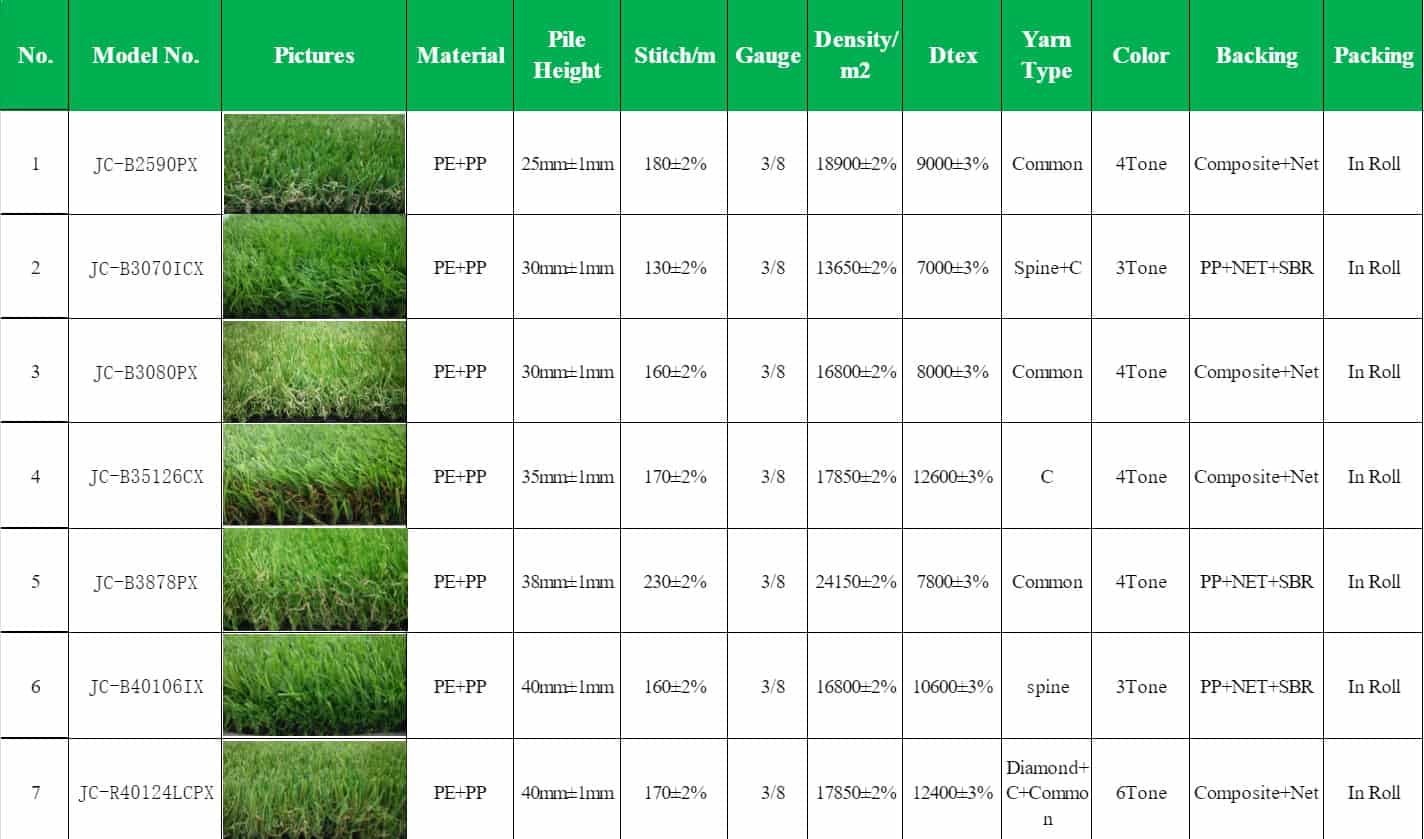Artificial turf nails keep grass secure, flat, and safe. The right nails prevent shifting, wrinkles, and edge lifting, while the wrong type — or too few — can cause repairs, hazards, and an unprofessional look.
In this guide, you’ll learn:
The types of nails for artificial turf and how to choose them.
The role of nails in turf installation.
Step-by-step tips on how to nail down fake turf and secure edges.
Maintenance advice and common nail-related issues.
Whether for a garden, playground, or sports field, knowing how to use turf nails is the key to a smooth and durable installation.
What nails do you use for fake grass?
When installing fake grass, choosing the right nails is one of the most important steps for a secure and long-lasting lawn. Different types of turf nails vary in strength, durability, and cost. Here’s a comparison of the most common options:
| Nail Type | Pros | Cons | Best Use |
| Galvanized Spiral Nails | Rust- and corrosion-resistant; spiral design provides superior grip; highly durable | Slightly more expensive | Yards, playgrounds, sports fields, high-traffic areas |
| 6-inch Galvanized Nails | Deep penetration into the base; strong rust resistance; industry standard | Requires more effort to install | Most artificial grass projects, especially edges and seams |
| Stainless Steel Nails | Excellent corrosion resistance; ideal for wet or humid conditions | Higher cost | Coastal areas, poolside lawns, or damp environments |
| Non-Galvanized Nails | Cheap and easy to find | Rust quickly, weak hold, may leave stains | Not recommended |
| Landscape Staples / U-Pins | Easy to install, useful for securing weed barrier fabric | Provide less holding power; may loosen over time | Small gardens, light-duty turf projects |
Best nails for artificial turf
For most artificial turf installations, the best choice is 6-inch galvanized spiral nails, combining strength, durability, and corrosion resistance.
- Length: Long enough to penetrate deep into the compacted base.
- Spiral design: Creates friction and prevents turf movement.
- Galvanized finish: Protects against rust and corrosion.
- Performance: Reliable even in high-traffic or changing weather conditions.
Stainless Steel Nails (secondary option): Ideal for use in wet or coastal environments. Higher cost but excellent durability.
Avoid non-galvanized nails: They rust quickly, weaken over time, and may stain your turf.
Do you need nails or U-pins for artificial grass?
Both nails and U-pins can be used when installing artificial grass, but they serve different purposes:
Nails (Best Choice)
- Drive deeper into the base (soil or compacted aggregate).
- Provide a stronger, more permanent hold.
- Recommended for edges, seams, slopes, and high-traffic areas.
- Galvanized spiral nails are the industry favorite for durability and grip.
U-Pins (Supplementary)
- Work well for holding down weed barrier fabric or lighter turf on flat ground.
- Easier to install and remove for adjustments.
- Not as reliable for long-term turf anchoring.
For a secure and professional installation, nails are essential. U-pins can be a helpful addition but should not replace nails for the main installation.
Nails vs. Staples: Which Should You Choose?
- Nails: Best for deep penetration, perimeter security, seams, slopes, and high-traffic areas.
- Staples: Useful for weed barrier fabric or lighter lawns on flat surfaces.
In general, nails are more reliable for long-term turf installation, while staples are a supplementary tool.
How to Choose the Right Nails for Artificial Grass
When making your choice, focus on three key factors:
Material: Always use galvanized or stainless steel nails. Galvanized nails are coated to resist rust, making them the most popular option for landscaping and sports turf. Stainless steel nails offer maximum corrosion resistance and are best in humid or coastal environments. Avoid non-galvanized nails, as they rust quickly and weaken over time.
Design: Spiral or ribbed nails grip the soil better than straight nails. This prevents movement and ensures the turf stays in place even with heavy foot traffic.
Size & Quantity: Nails should be long enough to penetrate the turf and compacted base, and you’ll need enough of them to anchor every seam, edge, and center section of the lawn.
How many nails for artificial grass?
The number of nails you need depends on the size of your project and how much traffic the turf will handle. A simple rule of thumb is:
- Perimeter: Place a nail every 6–8 inches along all edges.
- Seams: Use nails every 4–6 inches on top of seam tape to keep joints flat.
- Main Area: Add a nail every 1–2 feet across the central surface.
- Overall estimate: Around 150 nails per 1,000 sq. ft. of artificial grass.
Tip: Keep extra nails on hand for curves, corners, and high-use areas. More nails mean more stability, and it’s better to slightly over-secure than under-secure your turf.
How long should nails be for artificial grass?
6-inch nails are the industry standard for artificial grass.
- Long enough to penetrate turf backing, weed barrier fabric, and compacted base.
- Provide a secure hold against lifting or shifting.
- In soft soil, slightly longer nails may be required.
In very compact or rocky bases, 5-inch nails can sometimes work, but 6-inch galvanized nails remain the safest option.
In short: 6-inch galvanized spiral nails strike the perfect balance of depth, durability, and rust resistance.
What pins are used to hold down fake grass?
The most common pins for fake grass are U-shaped landscape staples, also called U-pins.
Design & Material: Usually 4–6 inches long, made from galvanized steel to resist rust.
Function: Press over the turf backing and into the ground to hold down weed barrier fabric, edges, or light turf.
Advantages: Easy to install and remove, useful for small or temporary projects.
Limitations: Provide less holding power than 6-inch galvanized spiral nails, so not ideal for high-traffic or long-term use.
U-pins are a good supplement but not a substitute for nails. Nails remain the main anchoring method, while pins add extra stability where needed.
The Role of Nails in Artificial Grass Installation
Nails may look minor, but they are essential for keeping artificial turf secure and professional-looking. Their main functions include:
Anchoring the Turf: Nails fasten the turf backing into the compacted base (soil, gravel, or stone), preventing shifting under foot traffic or weather.
Securing the Perimeter: Along edges, nails stop curling or lifting, which can cause hazards and ruin appearance.
Holding Seams Together: Used with seam tape, nails keep joints flat and seamless, making the lawn look continuous.
Maintaining Alignment: Proper spacing helps blades stay upright and reduces ripples or uneven patches.
Ensuring Long-Term Stability: Nails resist soil movement, freeze-thaw cycles, and daily wear, helping turf last 10–15 years.
How to Nail Down Fake Turf?
Nailing down fake turf is a step-by-step process that ensures your lawn stays flat, secure, and professional for years. The goal is to anchor the turf firmly without damaging the blades or creating visible bumps. Follow these steps:
Prepare the Base: Compact the soil or aggregate base until it’s stable and level. Install a weed barrier fabric to block unwanted growth.
Lay the Turf: Roll out the artificial grass smoothly, ensuring the grain (blade direction) faces the same way. Trim edges with a utility knife for a precise fit.
Secure the Perimeter: Use 6-inch galvanized spiral nails every 6–8 inches along edges. Insert nails between the blades, not through them, so they stay upright.
Fix the Seams: Place seam tape underneath the joint. Nail every 4–6 inches along the seam line to keep it flat and invisible.
Anchor the Main Area: Add nails every 1–2 feet across the center of the turf. This prevents ripples, shifting, or air pockets.
Set Nails Correctly: Hammer nails until flush with the turf backing—not sticking up, not overdriven. A rubber mallet works best to avoid bending nails.
Final Touches: Brush the turf with a stiff broom so blades cover the nails. Add infill if required for stability and natural appearance.
Artificial Turf Nail Maintenance & Common Issues
Artificial turf nails need regular checks to ensure the lawn stays safe, smooth, and durable. Weather, soil movement, or heavy traffic can cause problems over time.
Common Issues
- Rust/Corrosion – Non-galvanized nails rust quickly, weakening hold and staining turf edges.
- Loose or Raised Nails – Caused by soil shifts, freeze-thaw cycles, or foot traffic; can be a tripping hazard.
- Bent Nails – Result from hard soil or poor installation; reduce anchoring strength.
Maintenance Tips
- Inspect Regularly – At least once a year, and after storms or heavy use.
- Check Edges & Seams – These areas loosen first.
- Replace Damaged Nails – Use 6-inch galvanized spiral or stainless steel nails.
- Re-secure Loose Nails – Tap flush with a mallet; never leave nails exposed.
With routine inspections and timely replacements, turf nails will keep your artificial grass secure and long-lasting.
Is artificial turf nailed down?
Yes. Artificial turf is typically secured with 6-inch galvanized spiral nails along the edges, seams, and central areas. This keeps the turf flat, stable, and long-lasting.
Do you have to nail down artificial grass?
Yes. Nails are essential to prevent turf from shifting, wrinkling, or curling at the edges. Adhesive or staples alone are not enough for durable installations.
How to secure artificial turf edges?
Secure edges by placing nails every 6–8 inches along the perimeter. Insert nails between blades so they stay upright, and tap them flush with a mallet for a safe, invisible hold.
What’s best to stick artificial grass down?
The best method is a combination of seam tape, adhesive, and nails. Adhesive bonds seams, while nails provide mechanical strength to keep turf secure under foot traffic and weather.
Can you screw down artificial grass?
Not recommended. Screws are harder to install, may damage the backing, and don’t provide the same flexible hold as nails. Galvanized nails are the preferred method.
Trusted Artificial Turf Supplier and Manufacturer for Lasting Quality
Now you know the secret to a long-lasting, smooth, and secure artificial turf installation — it all comes down to choosing the right nails and fastening techniques. A strong base and proper installation ensure performance, but the quality of the turf itself is just as important.
At JCturf, we are a dedicated artificial turf supplier and manufacturer, specializing in producing high-quality synthetic grass for landscaping, playgrounds, sports fields, and commercial projects. While we don’t provide installation services, our turf products are designed to work perfectly with professional-grade accessories like galvanized nails and seam tape, helping you or your contractor achieve the best possible results.
If you’re looking for a trusted artificial turf manufacturer, contact JCturf today to explore our product range and request a free quote. With our durable, realistic, and low-maintenance turf, your project will not only be securely installed but also look beautiful for years to come.


